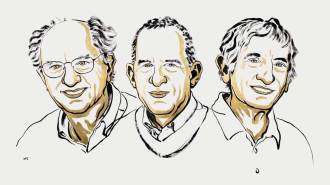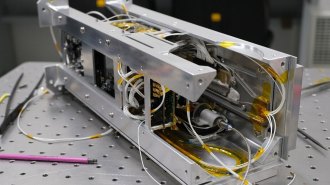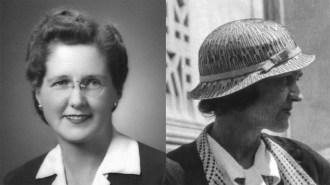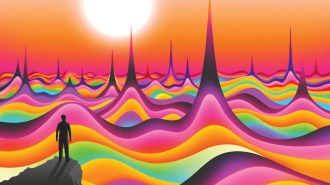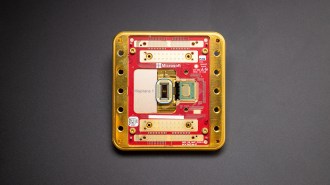Nobel laureates offer new interpretations of quantum mysteries

Like the way flipping a coin represents the dual possibilities of heads or tails, the quantum mathematical expression for computing probabilities of measurement outcomes describes multiple realities existing simultaneously. Some physicists have therefore suggested that the quantum mathematical expression does not have actual physical significance.
Jhi L. Scott, USN/Wikimedia Commons
- More than 2 years ago
First of two parts
Writing about the paradoxical nature of quantum mechanics poses a peculiar paradox of its own. If you explain it well enough that your readers understand it, you’ve somehow committed a gross error, because (as Feynman famously said) nobody really understands quantum mechanics.
But don’t worry. There is no danger that anybody reading this blog will come away understanding it. Nevertheless there are some new developments in the never-ending quest to explain quantum physics that, even if hard to understand, are worth knowing about. Especially considering where these new developments come from. Two giants of 20th century physics have recently offered 21st century views on how to interpret the quantum math that requires the subatomic world to be so weird.
The giants are Steven Weinberg (Nobel 1979) and Gerard ’t Hooft (Nobel 1999). They both played key roles in forging the modern understanding of particles and forces known as the standard model. They share a deep concern about the issues afflicting efforts to understand the foundations of quantum mechanics. But they offer very different views on what to do about it.
For decades, physicists seeking a solid foundation for quantum mechanics have been proposing new interpretations of its math. There are now more quantum interpretations than Batman, Superman, Spider-Man and X-Men movies combined. None have succeeded in ending the debate over two enduring problems: what happens when a measurement is made on a quantum system, and what the hell is going on with “spooky” quantum entanglement.
Measurement is a crucial concept in quantum mechanics, because it doesn’t work like the traditional measurements of classical physics. In the old days everybody thought objects had properties, like the way a coin can show heads or tails. You find out which property it is showing by looking at it. But in quantum mechanics, the property doesn’t exist before the measurement. Quantum particles, such as photons or electrons, are like spinning coins, neither heads nor tails until you catch one.
Quantum mechanical math is therefore probabilistic. It tells you the odds of getting heads or tails. But once you make the measurement, the result is definite. No more probabilities. So the quantum mathematical expression used for computing the probabilities, called the wave function (or state vector), apparently just “collapses.” (There is a technical distinction between wave function and state vector that will be ignored unless it really matters.)
For the traditional “Copenhagen” interpretation, Weinberg notes, that collapse just expresses a “mysterious division between the microscopic world governed by quantum mechanics and a macroscopic world of apparatus and observers that obeys classical physics.” Hence some experts wonder whether the state vector is actually representative of reality at all. If it is, some have argued, then all the various possible outcomes must actually occur in some universe — “the endless creation of inconceivably many branches of history,” as Weinberg puts it. In other words, some important football games would have ended differently because the other team won the overtime coin toss.
Entanglement is even more mysterious, Weinberg suggests, because the state vector can change as a result of a measurement made very far away. When two particles interact, they form a composite quantum system, described by a single state vector, even when one particle flies far away from the other. The state vector tells the odds for outcomes of measurements on either of the two particles. But once you measure one of them, the odds for different outcomes for the other particle instantaneously change, no matter how far away the other particle is. Sounds like voodoo, which is maybe why Einstein called it “spooky.”
“The susceptibility of the state vector to instantaneous change from a distance casts doubts on its physical significance,” Weinberg writes in his new paper. If a statement describing a system’s state can be changed instantly by a faraway measurement, “it seems reasonable to infer that such statements are meaningless,” he declares. “That is, it seems worth considering yet another interpretation of quantum mechanics.”
Weinberg’s title for the paper on his new interpretation is “Quantum mechanics without state vectors.” It asserts that the state vector is not, in fact, the proper representation of reality. That role should rather be assigned to something called the density matrix.
“Density” in this context refers to probability densities; a matrix is just a mathematical expression in which numbers are arranged in rows and columns. When the state vector is unknown, quantum calculations use a density matrix to compute the odds of different measurement outcomes. (The density matrix represents the information you possess about the relative likelihood of various possible state vectors describing the system you’re going to measure.)
As Weinberg points out, a given set of state vectors will tell you what the density matrix is. But a given density matrix doesn’t tell you what the state vectors are, because different sets of state vectors can give the same density matrix. It’s kind of like the answer is 42, but you don’t know whether that came from 7×6 or 2×21 or 3×14. Since 42 is the number you need, there’s no reason to care about its possible factors. So Weinberg advocates doing away with all the fuss about state vectors and concentrating on density matrices instead.
“In speaking of ‘quantum mechanics without state vectors’ I mean only that a statement that a system is in any one of various state vectors with various probabilities is to be regarded as having no meaning, except for what it tells us about the density matrix,” he writes. “With this definition of a physical state, even in entangled states nothing that is done in one isolated system can instantaneously affect the physical state of a distant isolated system.”
Weinberg goes on to explore ways that new mathematical features of quantum mechanics might emerge if the density matrix is taken as the proper description of physical states. Whether deep new insights into physics will result from such explorations remains to be seen.
But even if quantum mechanics as we know it remains essentially unchanged, it’s still thinkable that something deeper will ultimately explain its weirdness. That’s the tactic of ’t Hooft, who for many years has argued that quantum probabilities mask a unique cause-and-effect “deterministic” reality, hidden from human view.
Various analyses and experiments seem to have ruled out the notion that “hidden variables” determine the fate of particle measurements for which quantum math can give only the odds. ’t Hooft does not dispute these experiments. But he suggests that quantum odds can nevertheless emerge from a deeper layer of reality in which everything is specified deterministically. He spells his views out in a new 202-page paper. Consequently it will require another 1,000-word blog post to explore his interpretation in sufficient detail to guarantee that it will be properly misunderstood.
Follow me on Twitter: @tom_siegfried

